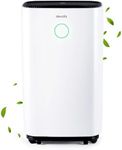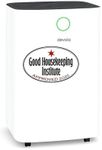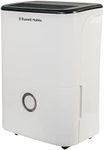Buying Guide for the Best Energy Efficient Dehumidifier
Choosing the right energy-efficient dehumidifier can make a significant difference in maintaining a comfortable and healthy indoor environment while also saving on energy costs. Dehumidifiers help reduce humidity levels, preventing mold growth and improving air quality. When selecting a dehumidifier, it's important to consider several key specifications to ensure you get the best fit for your needs.Energy EfficiencyEnergy efficiency is a measure of how much energy a dehumidifier uses to remove moisture from the air. This is important because a more energy-efficient model will cost less to operate over time. Look for dehumidifiers with an Energy Star rating, as these models meet strict energy efficiency guidelines set by the government. If you plan to use the dehumidifier frequently or in a large space, prioritizing energy efficiency can lead to significant savings on your electricity bill.
CapacityCapacity refers to the amount of moisture a dehumidifier can remove from the air in a 24-hour period, usually measured in pints. This is crucial because it determines how effective the dehumidifier will be in your space. Small capacity units (20-30 pints) are suitable for small rooms or areas with mild humidity. Medium capacity units (30-50 pints) are ideal for medium-sized rooms or moderate humidity levels. Large capacity units (50-70 pints) are best for large spaces or areas with high humidity. Choose a capacity that matches the size of the area and the level of humidity you need to control.
Coverage AreaCoverage area indicates the maximum square footage a dehumidifier can effectively handle. This is important to ensure the unit can manage the humidity levels in your entire space. Small units typically cover up to 300 square feet, medium units cover 300-700 square feet, and large units can cover 700 square feet or more. Measure the area you need to dehumidify and select a model that can cover at least that much space to ensure optimal performance.
Noise LevelNoise level is the amount of sound a dehumidifier produces while operating, usually measured in decibels (dB). This is important if you plan to use the dehumidifier in a living space, bedroom, or office where noise could be disruptive. Lower noise levels (below 50 dB) are ideal for quiet environments, while higher noise levels (above 50 dB) may be acceptable in basements or areas where noise is less of a concern. Consider where you will place the dehumidifier and choose a model with an appropriate noise level for that setting.
Drainage OptionsDrainage options refer to how the dehumidifier disposes of the collected water. This is important for convenience and maintenance. Some models have a built-in tank that needs to be manually emptied, which is suitable for occasional use or smaller spaces. Others offer continuous drainage with a hose connection, which is ideal for continuous use or larger spaces as it eliminates the need to empty the tank. Choose a drainage option that fits your usage pattern and maintenance preferences.
HumidistatA humidistat is a built-in sensor that measures the humidity level in the air and allows you to set a desired humidity level. This is important for maintaining consistent indoor humidity and preventing over-dehumidification, which can lead to overly dry air. Models with an adjustable humidistat let you set and maintain your preferred humidity level automatically. If you want precise control over your indoor environment, look for a dehumidifier with a reliable and easy-to-use humidistat.
PortabilityPortability refers to how easy it is to move the dehumidifier from one location to another. This is important if you need to use the dehumidifier in different rooms or areas. Features like caster wheels, handles, and a lightweight design enhance portability. If you plan to move the dehumidifier frequently, choose a model that is easy to transport and maneuver.











![NETTA Dehumidifier 800ml Mini Air Dehumidifier for Damp, Mould, Moisture, Portable and Ultra Quiet for Home, Bathroom, Bedroom, Kitchen, Wardrobe, Basement - White [Energy Class A+++]](https://images-proxy.bestreviews.guide/MXqmZpI6U8c9y84DsGvLObFFxDY=/0x150/https://m.media-amazon.com/images/I/31QIwtfcXWL._AC_CX679_.jpg)
![NETTA Dehumidifier 500ml Mini Air Dehumidifier for Damp, Mould, Moisture, Portable and Ultra Quiet for Home, Bathroom, Bedroom, Kitchen, Wardrobe, Basement - Grey [Energy Class A+++]](https://images-proxy.bestreviews.guide/nVkqjxkWZ8uo1hHMQKdn_531R0U=/0x150/https://m.media-amazon.com/images/I/41S12qL1D3L._AC_CX679_.jpg)



